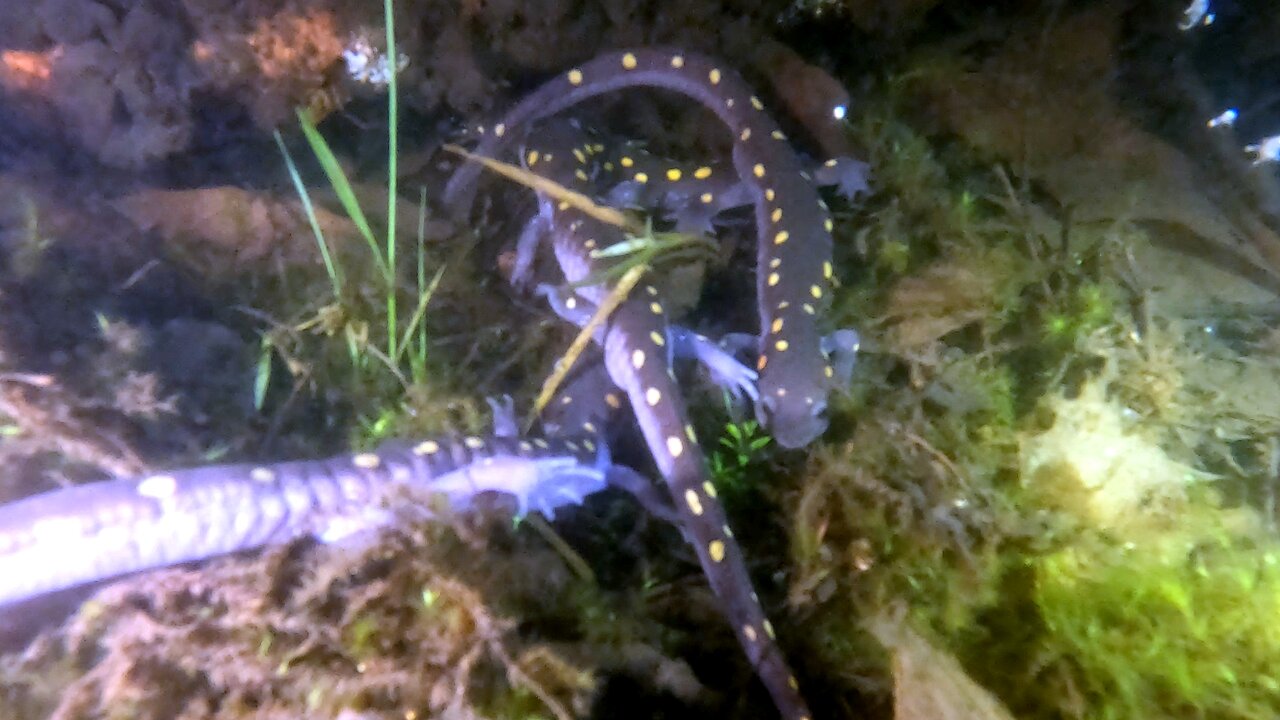Premium Only Content

Midnight snorkelers capture incredible salamander migration
Every spring, yellow-spotted salamanders migrate to vernal ponds to breed. The result is a frenzy of activity that lasts only 2-3 nights each year. It is a spectacle to behold. The salamanders make their long journey from the surrounding forest under the cover of darkness, usually after a rainfall. The males arrive at the pond first, depositing spermatophores on the leaves and branches in shallow water. The females come soon after, gathering up the spermatophores to fertilize the eggs that they are waiting to deposit.
Soon after the eggs are fertilized, the female will attach herself to a submerged plant stem or twig and she will release the eggs. The eggs are protected by a sticky, gelatinous mass that deters predators as the eggs develop for approximately 30 days. The eggs hatch into tadpoles, similar to frogs and toads. They spend their first few months in the water, breathing through gills.
Salamanders are amphibians. Once they leave the water, they spend most of their lives underground, occasionally coming out of their burrows to feed and also for breeding season in March to May each year. They are rarely seen, although they are plentiful in the forests that they inhabit.
Salamanders excrete a toxic, milky fluid when they are threatened. Salamanders are a major food source for birds, raccoons, foxes and other animals.
Salamanders feed on earthworms, spiders, slugs, snails, and other insects. They have the amazing ability to grow a new tail and new limbs if one is severed.
A salamander has the unique ability to lay two different types of egg masses. One type has a water-soluble, protein-based gel. The other type has a hydrophobic protein-based gel. This is believed to prevent predation by wood frogs. These eggs are combined with an algae that produces oxygen and removes carbon dioxide and nitrogen waste from developing embryos.
The complex relationships between organisms are only beginning to be understood. The health of our forests and our ecosystems depends on the survival of all species, no matter how small.
-
 1:45
1:45
WildCreatures
22 days ago $1.05 earnedGiant manta rays surround scuba divers in Galapagos Islands
3.13K2 -
 22:35
22:35
DeVory Darkins
13 hours ago $27.93 earned"Don't Call Me Stupid!" Election Guru HUMILIATED by Left Wing Host
73.6K76 -
 1:41:14
1:41:14
Megyn Kelly
15 hours agoMace's Quest to Protect Women's Spaces, and RFK vs. Media and Swamp, w/ Casey Means and Vinay Prasad
83.4K115 -
 5:08:25
5:08:25
Drew Hernandez
12 hours agoLAKEN RILEY'S KILLER CONVICTED & GIVEN LIFE IN PRISON
65.6K79 -
 59:31
59:31
Man in America
17 hours agoEven WW3 Can't Stop What's Coming—the Cabal is COLLAPSING w/ Todd Callender
126K83 -
 3:51:28
3:51:28
I_Came_With_Fire_Podcast
17 hours agoSPECIAL LIVE FIRE w/ Bearded Viking Mead Co
93.3K9 -
 1:28:52
1:28:52
Kim Iversen
15 hours agoUnmasking the Truth: Most Censored Historian On Past Election Meddling, COVID, and Trump
88.7K95 -
 2:10:00
2:10:00
TheSaltyCracker
13 hours agoNow Lefties Lose Bathroom War ReeEEeE Stream 11-20-24
163K466 -
 1:03:31
1:03:31
Fresh and Fit
14 hours agoWhy Men Need Options To Avoid Falling For This!
127K19 -
 1:26:56
1:26:56
Flyover Conservatives
1 day agoWar Raging, Bank Closing, and Humanoid Robots: It’s Biblical! - Clay Clark | FOC Show
61.2K21